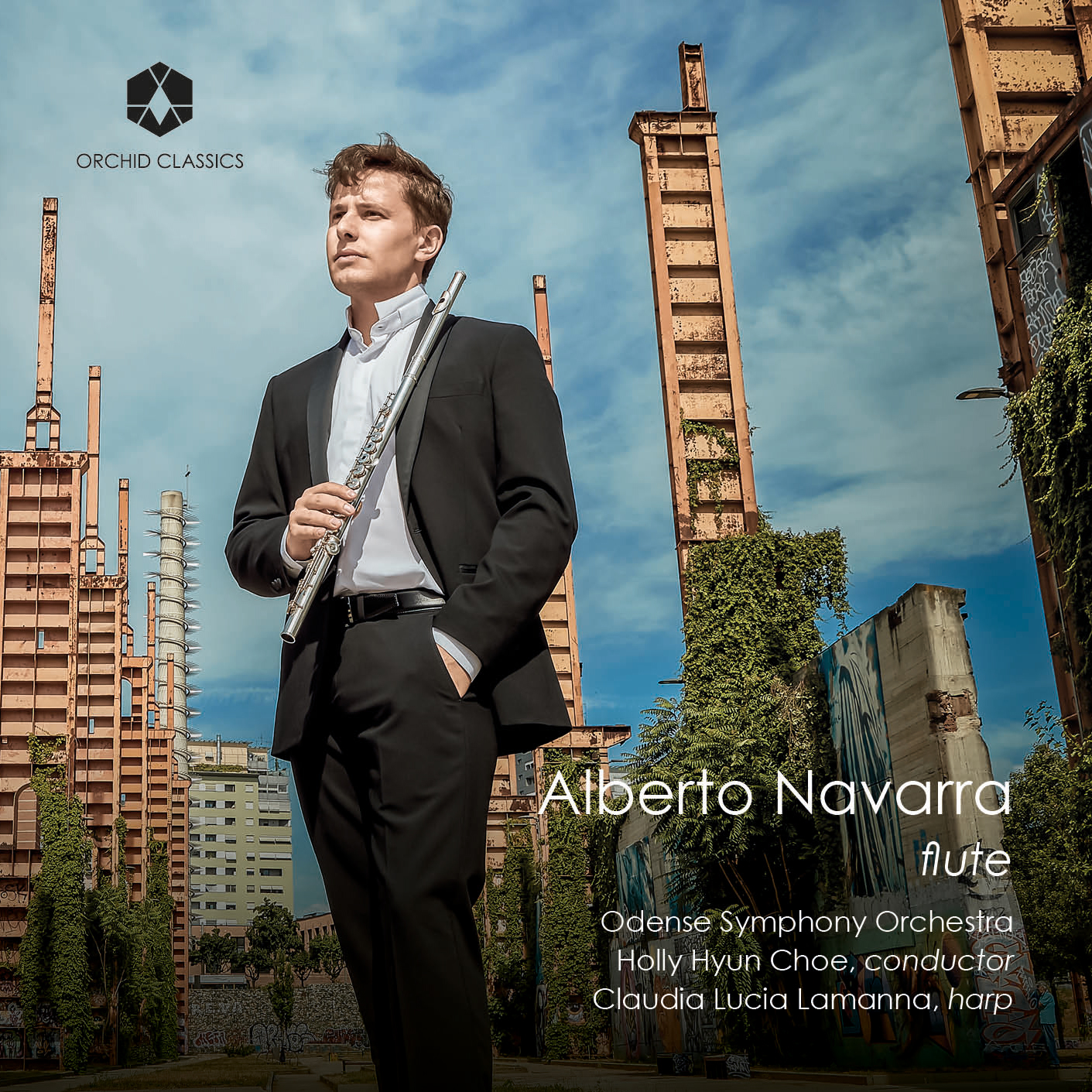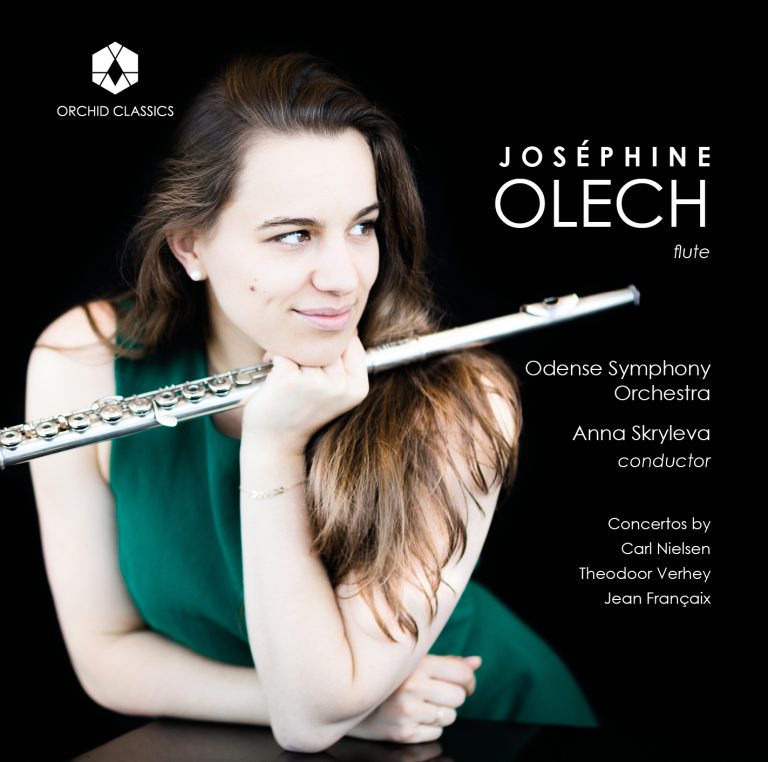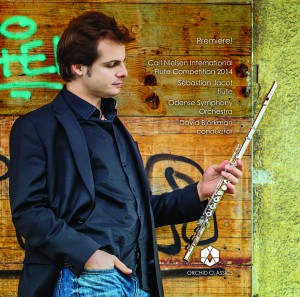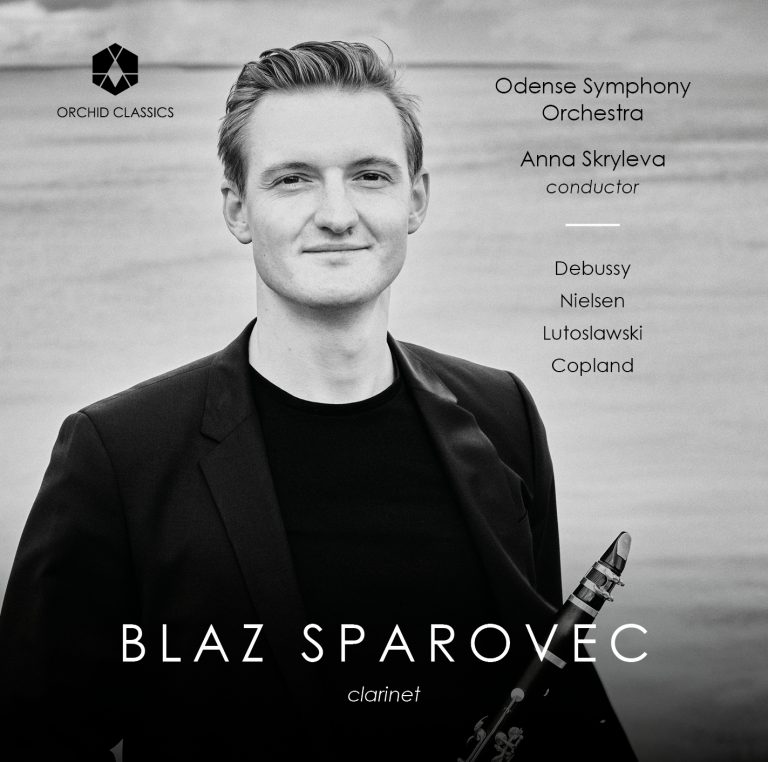Artist Led, Creatively Driven

Alberto Navarra (flute);
Claudia Lucia Lamanna (harp);
Odense Symphony Orchestra;
Holly Hyun Choe (conductor)
Release Date: 15th Mar
ORC100287
Wolfgang Amadeus Mozart (1756-1791)
Concerto for Flute and Harp in C Major, K.299
1. I Allegro
2. II Andantino
3. III Rondo. Allegro
Carl Reinecke (1824-1910)
Flute Concerto in D Major, Op.283
4. I Allegro molto moderato
5. II Lento e mesto
6. III Finale. Moderato
Carl Nielsen (1865-1931)
Flute Concerto, FS 119
7. I Allegro moderato
8. II Allegretto un poco
Mozart’s Concerto for Flute and Harp, K.299, is the last of a group of concert pieces written for the flute, all within a fairly brief timeframe. He had composed the two Flute Concertos K.313 and K.314, and the Andante in C, K.315, early in 1778 while in Mannheim (where he was delighted by the orchestra’s inclusion of clarinets – although he clearly appreciated the instrument in combination with the flute: ‘Ah! If only we too had clarinets! You can’t believe the wonderful effect produced by a symphony with flutes, oboes and clarinets!’). These three works were written for the amateur flautist Ferdinand Dejean, whose reluctance to pay Mozart until all the pieces were finished provoked Mozart’s famous fit of pique in a letter to his father, Leopold: ‘… you know I am quite powerless to write for an instrument that I cannot bear’. There are no other known examples of Mozart disdaining the instrument, however, so this may well have been a means of distracting from his slowness at completing the commission.
On the other hand, Mozart clearly favoured mellower textures – he preferred playing the viola to the violin, for example – and while ‘galant’ composers went in for airy, even mannered writing that eschewed Baroque intricacy, even Mozart’s lightest confections are informed by a deeper understanding of form and counterpoint. This may explain why the harp, which though naturally elegant was yet to have its capacity for complexity fully explored, was not an instrument to which he was conspicuously drawn: the Flute and Harp Concerto is his only work to include the instrument. The work was composed in April 1778, by which time Mozart was in Paris, and the commission came from another amateur flautist, the Comte de Guines, Adrien-Louis Bonnières de Souastre, once a French envoy to England. Mozart taught the Comte’s daughter, whose harp playing he described as ‘magnifique’, and so it was that he ended up writing for both instruments together. The Comte’s flute had an extension that allowed him to play low D-flat and C, which were not possible on most flutes of the time, and Mozart made the most of this range in the concerto. Indeed, whatever his reservations about the instruments individually, in combination they seem to have inspired him. Frustratingly, the Comte was, like Dejean, slow to pay, and four months later Mozart was still awaiting remuneration.
In keeping with the treatment of the harp at the time, Mozart used it in a similar manner to the piano or guitar, its radiant strumming and intricate lines marrying well with the flute’s lyricism, both of which shine through light orchestral forces. The sprightly opening movement begins with an orchestral introduction presenting two themes. The soloists take up the themes and proceed to alternate melodic and accompanimental roles, sometimes in dialogue or counterpoint, sometimes with the orchestra, and at other times forming an intimate duo; there is a cadenza towards the end of the movement.
Mozart balances the timbres of the soloists with rich, ‘divisi’ violas in the sublime slow movement, in which a series of variations showcases the range of both instruments. Mozart called the finale a ‘Rondeau’ (a nod to his French patron), but its structure is rather distinctive, unfolding as a series of episodes with some recurring ideas, though not in the strictest sense of rondo form. Regardless, the effect is one of lively, ebullient conversation between protagonists and ensemble.
Carl Reinecke’s relationship with both the flute and the harp seems to have been easier than Mozart’s; his most successful concertos are his Harp Concerto (1885) and the later Flute Concerto in D major. Reinecke was a respected composer, teacher and pianist, praised by Liszt for his ‘beautiful, gentle, legato and lyrical touch’. As conductor of the Gewandhaus Orchestra in Leipzig, where he was music director at the Conservatory, Reinecke had exacting standards, expecting a high level of virtuosity and clarity from his players. This is reflected in the demanding nature of much of his music, of which perhaps the most frequently played example is his Sonata for Flute and Piano, Undine.
Reinecke’s affinity with the flute is evident in his Flute Concerto as well. Composed in 1908, this was the last concerto Reinecke wrote before his death in 1910; the premiere was given in Leipzig in 1909 by its dedicatee, Maximilian Schwedler. Despite being written at a time when musical innovations were proliferating, the concerto reflects Reinecke’s musical conservatism; he was a staunch believer in studying Baroque and Classical models, and stylistically showed the influence of Mendelssohn and Schumann (both of whom he knew) even during the first decade of the 20th century. There is something Brahmsian about this concerto, too, which opens with a warm, romantic sonority from which the soloist emerges, articulating an almost improvisatory line, with folk-like ornamentation. The developments in instrumental technique and style since Mozart’s time are soon apparent, with virtuoso flourishes offset by colourful, sometimes stormy orchestral passages. The elegiac slow movement (marked con dolore) is a soulful lament over brooding, funereal orchestral writing, while the rondo finale is compelling and varied, with both the virtuosic and voice-like qualities of the flute to the fore, building to a joyful conclusion.
Carl Nielsen completed three concertos, for violin, flute and clarinet. His intention had been to write concertos for each member of the Copenhagen Wind Quintet after hearing the group performing Mozart in 1921, but he only managed two, following his Wind Quintet of 1922: the Flute Concerto of 1926 for the quintet’s fastidious flautist, Holger Gilbert-Jespersen, and the Clarinet Concerto of 1928.
This flurry of activity came relatively late in Nielsen’s life; the Flute Concerto was his first major work following the completion of his Sixth (and last) Symphony. It was composed in the aftermath of a spell of poor health that had hindered the composer for much of 1926. In August of that year he rallied sufficiently to travel to Munich as part of a group of advisors testing the installation of a new Danish radio mast. Nielsen brought the manuscript of the concerto with him and worked on it in Munich, as well as during subsequent trips to Florence and Tuscany. He was unwell again in September and had to dash off a temporary conclusion for the work’s premiere on 21 October in Paris, where it was conducted by his son-in-law, Emil Telmányi. Even in its unfinished state, the work was so well received that it was performed again in the same curtailed form in November, in Oslo, with the composer conducting. At last, in January 1927, Nielsen was able to unveil the finished product for a performance in Copenhagen.
Nielsen argued that ‘the flute cannot deny its own nature, its home is in Arcadia, and it prefers pastoral moods. Hence, the composer has to follow the mild character of the instrument if he did not want to run the risk of being called a barbarian’. Accordingly, Nielsen’s Flute Concerto is full of pastoral writing for the soloist, contrasted with its polar opposite, the bass trombone, with whom the flute spars throughout. There is little hint of this ‘mild character’ in the curt, dissonant orchestral introduction after which, as Nielsen put it, ‘the solo instrument moves about as if seeking something, until it takes hold of a more decisive motive’. There is an ongoing conflict between the key areas of D minor and E flat, tempered by the flute’s lyrical material, which leads us into a gentle secondary theme. When the bass trombone, punctuated by timpani, emerges, the flute responds as though affronted before asserting its dominance with an expansive melody and three brief cadenzas, the last of which also features clarinet and bassoon.
The second-movement Allegretto contrasts jutting orchestral passages with more fluid writing for the flute, softening to a wistful Adagio ma non troppo. These elements are reprised before Nielsen transforms them into an increasingly agitated march, after which the bass trombone returns, eventually settling the movement in the key of E flat before interrupting the last bars with raucous glissandi, its brash tones providing an earthy backdrop to the flute’s gleaming triumph.
© Joanna Wyld, 2023
Alberto Navarra
Flute
“Alberto is a leading talent of his generation… he has since distinguished himself by winning 1st Prize at the Nielsen International Competition 2022 and winning the Audition for the Karajan Academy of the Berlin Philarmonic. Both processes started with a video selection of roughly 200 candidates. Most important, it is then on stage and with live acoustics that Alberto made a tremendous difference, by his tone projection, his stage presence, his musical ideas.” – Emmanuel Pahud
Alberto Navarra gained notable recognition in the Spring of 2022, winning the Carl Nielsen International Flute Competition in Odense (Denmark), adding further prestige to his portfolio of recent competition successes including the Severino Gazzelloni International Flute Competition (Italy) in 2021 and Dorel Baicu International Competition (Romania) in 2020.
In the 2022-24 seasons, Alberto joined the Berliner Philharmoniker as a member of the prestigious Karajan Akademie, studying and performing alongside world renowned flautists Emmanuel Pahud, Sebastian Jacot and the entire BPO flute section. With the Berliner Philharmoniker, he has already had the opportunity to play in prestigious international festivals, such as the Salzburg Festspiele, Osterfestspiele in Baden Baden, Lucerne Festival and BBC Proms in London; under the direction of conductors such as Kirill Petrenko, Ivan Fisher, François-Xavier Roth, Christian Thielemann, Tugan Sokhiev and others. Alberto recently won the audition as “Solo-Flöte mit 2./3. Flöte” of the Tonhalle-Orchester Zürich under the baton of Paavo Järvi.
In 2023, Alberto was nominated onto the Classeek Ambassador Programme by Emmanuel Pahud, where he received solo and chamber recital opportunities in Geneva and Aubonne, Switzerland.
As a soloist, Alberto has performed with many orchestras like: Aarhus Symfoniorkester, Odense Symfoniorkester, Tampere Filharmonia, Royal Stockholm Philharmonic Orchestra and many others. As a principal flautist, he has collaborated with orchestras and ensembles such as the Konzerthaus Orchester, Orchestra del teatro “La Fenice” in Venice, La Filarmonica di Milano, Solisti di Pavia, Ensemble Albéniz, Orchestra Haydn di Bolzano e Trento, Orquesta Freixenet and Orquestra Simfònica de Barcelona and many others.
Alberto regularly collaborates with a range of chamber groups, performing across numerous festivals in Italy and Europe. Born in Mondovì, Italy, he began his musical education with Maurizio Valentini at the Conservatorio di Musica Ghedini in Cuneo, followed by further studies with Andrea Manco and Andrea Oliva at the International Academy of Imola and National Academy of Santa Cecilia in Rome. Awarded with scholarships to continue his studies, from Fundación Albéniz and by Francesco and Marina Moncada di Paternò, in 2019 he joined the Escuela Superior de Música Reina Sofía in Madrid as a student of Jacques Zoon and Salvador Martinez Tos. Here he was also awarded the “más sobresaliente”, student of the year, presented by Queen Sofía of Spain.
Alberto has been selected as a winner of the Desono’s Scholarship for the academic year 2023/24.
Claudia Lucia Lamanna
Harp
First Prize Winner at the prestigious 21st International Harp Contest in Israel in 2022, Italian harpist Claudia Lucia Lamanna is one of the most thrilling soloists of the new generation. She is also prize winner in over 30 international competitions in United Kingdom, Italy, Thailand, USA, France, Germany and Sweden.
As a soloist, Claudia toured in many venues, as Oslo Opera House, Salle Colonne in Paris, Kolarac Concert Hall in Belgrade, Dora Stoutzker Concert Hall in Cardiff, Teatro Petruzzelli in Bari, Sala Baldini in Rome, Teatro Duse in Bologna, Norrköping Concert Hall, Sheung Wan Civic Centre in Hong Kong, Tlaqná Cultural Center in Xalapa, House of Arts in Košice, Art and Culture Hall in Bangkok, and she was invited to perform in several Festivals, such as Classic’Antibes, World Harp Congress, International Harp Festival in Belgrade, Pratté International Harp Festival, North London Festival, Harp on Wight International Festival, Proms at St Jude’s Festival, Thailand International Harp Festival, Wales International Harp Festival, Ancenis International Harp Festival, among others.
As soloist with orchestra, she played with the Orchestre National de Cannes, the Jerusalem Symphony Orchestra, the Orquesta Sinfónica de Xalapa, the Slovak State Philharmonic Košice, the Orchestra Sinfonica Metropolitana di Bari and many others. In 2020, Claudia Lamanna released her debut album Claudia Lucia Lamanna – Royal Academy of Music Bicentenary Series with the record label Linn Records, making a harp recital built around the leitmotiv of variation, and it’s now available on all digital platforms. In the same year, she published the transcription for harp of the Variaciones del Fandango español by Félix Máximo López, which represents a totally new addition to the harp repertoire.
After her Master’s Degree with top honors at the Conservatorio di Musica “Nino Rota” of Monopoli (Italy), she continued her studies at the Norwegian Academy of Music in Oslo, where she achieved the Artist Diploma, and at the Royal Academy of Music in London, where she obtained the Advanced Diploma in Performance and where she was the only harpist to be selected to join the prestigious Bicentenary Scholarship scheme. She finally completed her education at the University Mozarteum in Salzburg. Claudia was also the harpist of La Scala Academy Orchestra in Milan for 2017-2019.
Claudia performs on a Camac Harp.
www.claudialucialamanna.com
Holly Hyun Choe
Conductor
Holly Hyun Choe, born in South Korea and raised in Los Angeles, impresses with her presence and charisma on the podium. From 2020/21 to 2021/22, she has served as assistant conductor of the Tonhalle-Orchester Zürich under Paavo Järvi. At the same time she has already conducted the Orchestre de Paris, Sinfonieorchester Basel, and the Schleswig- Holstein Festival Orchestra.
In the 2023/24 season the up-and-coming conductor will continue her series of exciting debuts on the podium of orchestras such as Deutsches Symphonie-Orchester Berlin, the Beethovenorchester Bonn, Musikalische Akademie Mannheim, Estonian National Symphony Orchestra, the Spokane Symphony Orchestra, and Orchestre National de Cannes. Also, she will start her role as Artiste Associée of the Geneva Chamber Orchestra for the next three seasons.
Further, Holly Hyun Choe holds the position of principal conductor of the chamber orchestra Ensemble Reflektor, which envisions itself as a messenger of music culture without boundaries. Together, they will make their debut at the Beethovenfest Bonn and return to the Schleswig-Holstein Musik Festival / Elbphilharmonie as well as to Alte Oper Frankfurt.
As part of her commitment to promoting female composers, she regularly programmes works by Clarice Assad, Grazyna Bacewicz, Lili Boulanger, Britta Byström, Louise Farrenc, Fanny Hensel, Jennifer Higdon, Jessie Montgomery, Emilie Mayer, Caroline Shaw, Ethel Smyth, Dobrinka Tabakova, Anna Thorvaldsdottir, and Galina Ustvolskaya.
Holly Hyun Choe recently completed her studies with Prof. Johannes Schlaefli at the Zurich University of the Arts. She began her musical journey self-taught: having learned to play the clarinet at the age of 13 by herself, she did not receive her first music lessons until the age of 19. In 2015, Holly Hyun Choe completed a master’s degree with Prof. Charles Peltz at the New England Conservatory. She has attended master classes with Bernhard Haitink, Jorma Panula, Fabio Luisi (Concertgebouw Orkest), Peter Eötvös, Sylvia Caduff, and Jaap van Zweden, and has assisted Esa-Pekka Salonen (Orchestre de Paris), Leonard Slatkin (Orchestre national de Lyon), Simone Young (Orchestre de Chambre de Lausanne/Zurich Opera), as well as François-Xavier Roth, and Karina Canellakis (Gürzenich-Orchester Cologne).
In 2018, she was selected for the German Music Council’s Grant Forum Dirigieren; she has also been supported by a Solti Foundation Career Assistance Award, a scholarship of the Taki Alsop Conducting Fellowship, and as a participant in the Peter Eötvös Foundation Mentoring Programme.
Odense Symphony Orchestra
The Odense Symphony Orchestra is one of Denmark’s five regional orchestras. The orchestra was founded in 1946, but its roots go as far back as around 1800. From being a theatre orchestra that also played symphonic music, the orchestra today appears as a modern symphony orchestra with a high level of activity and in a constant state of development. The orchestra’s repertoire has a wide range and covers everything from film concerts, chamber music, family concerts to the great symphonic works and opera, such as Richard Wagner’s Der Ring des Nibelungen.
Odense Symphony Orchestra had 22 musicians at its founding, but has grown to 73 permanent musicians over the years, from Denmark and all over the world. The orchestra performs around 100 concerts a year. The majority of the concerts take place in the Carl Nielsen-hall in Odense’s Concert house, near H.C. Andersen’s Birthplace – but the orchestra tours throughout Denmark and the rest of the world.
Odense Symphony Orchestra is the owner and host of Carl Nielsen International Competition, and the orchestra and its musicians play an important role in the competition as jury members, repertoire consultants and contact persons to many international artists.
The first of the Carl Nielsen International Competitions was held in Odense in 1980. After nearly four decades, the violin, clarinet and flute competitions have established themselves as some of the most demanding and rewarding in the world, by highlighting Carl Nielsen’s musical masterpieces, and offering each winner the chance to launch a significant international career.
www.carlnielseninternationalcompetition.com









